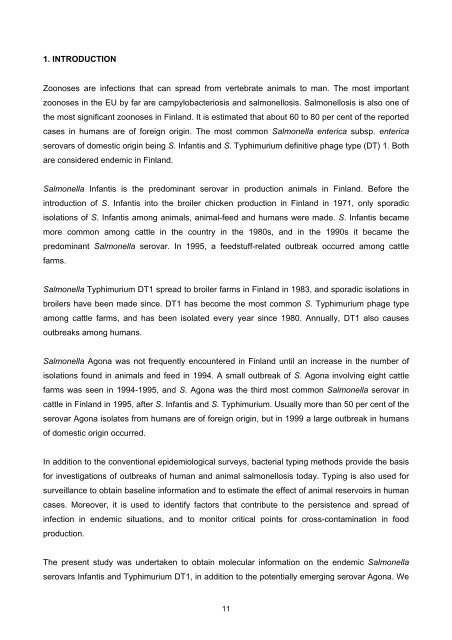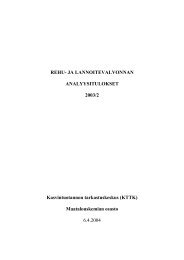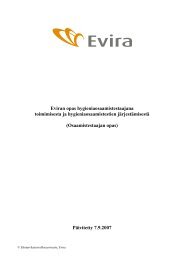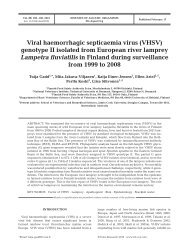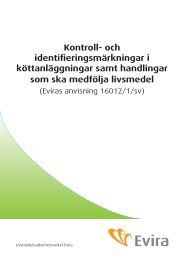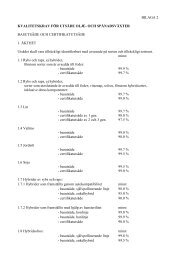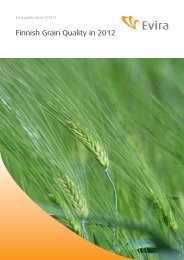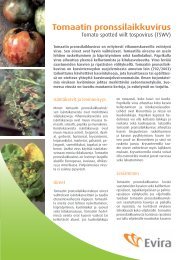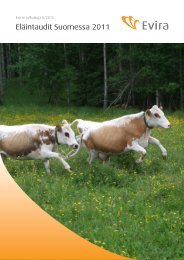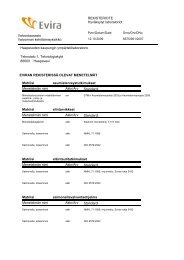Molecular characterization of endemic salmonella infections ... - Evira
Molecular characterization of endemic salmonella infections ... - Evira
Molecular characterization of endemic salmonella infections ... - Evira
You also want an ePaper? Increase the reach of your titles
YUMPU automatically turns print PDFs into web optimized ePapers that Google loves.
1. INTRODUCTION<br />
Zoonoses are <strong>infections</strong> that can spread from vertebrate animals to man. The most important<br />
zoonoses in the EU by far are campylobacteriosis and salmonellosis. Salmonellosis is also one <strong>of</strong><br />
the most significant zoonoses in Finland. It is estimated that about 60 to 80 per cent <strong>of</strong> the reported<br />
cases in humans are <strong>of</strong> foreign origin. The most common Salmonella enterica subsp. enterica<br />
serovars <strong>of</strong> domestic origin being S. Infantis and S. Typhimurium definitive phage type (DT) 1. Both<br />
are considered <strong>endemic</strong> in Finland.<br />
Salmonella Infantis is the predominant serovar in production animals in Finland. Before the<br />
introduction <strong>of</strong> S. Infantis into the broiler chicken production in Finland in 1971, only sporadic<br />
isolations <strong>of</strong> S. Infantis among animals, animal-feed and humans were made. S. Infantis became<br />
more common among cattle in the country in the 1980s, and in the 1990s it became the<br />
predominant Salmonella serovar. In 1995, a feedstuff-related outbreak occurred among cattle<br />
farms.<br />
Salmonella Typhimurium DT1 spread to broiler farms in Finland in 1983, and sporadic isolations in<br />
broilers have been made since. DT1 has become the most common S. Typhimurium phage type<br />
among cattle farms, and has been isolated every year since 1980. Annually, DT1 also causes<br />
outbreaks among humans.<br />
Salmonella Agona was not frequently encountered in Finland until an increase in the number <strong>of</strong><br />
isolations found in animals and feed in 1994. A small outbreak <strong>of</strong> S. Agona involving eight cattle<br />
farms was seen in 1994-1995, and S. Agona was the third most common Salmonella serovar in<br />
cattle in Finland in 1995, after S. Infantis and S. Typhimurium. Usually more than 50 per cent <strong>of</strong> the<br />
serovar Agona isolates from humans are <strong>of</strong> foreign origin, but in 1999 a large outbreak in humans<br />
<strong>of</strong> domestic origin occurred.<br />
In addition to the conventional epidemiological surveys, bacterial typing methods provide the basis<br />
for investigations <strong>of</strong> outbreaks <strong>of</strong> human and animal salmonellosis today. Typing is also used for<br />
surveillance to obtain baseline information and to estimate the effect <strong>of</strong> animal reservoirs in human<br />
cases. Moreover, it is used to identify factors that contribute to the persistence and spread <strong>of</strong><br />
infection in <strong>endemic</strong> situations, and to monitor critical points for cross-contamination in food<br />
production.<br />
The present study was undertaken to obtain molecular information on the <strong>endemic</strong> Salmonella<br />
serovars Infantis and Typhimurium DT1, in addition to the potentially emerging serovar Agona. We<br />
11


